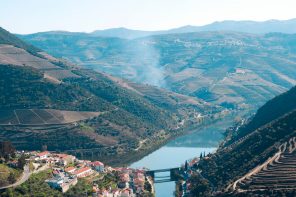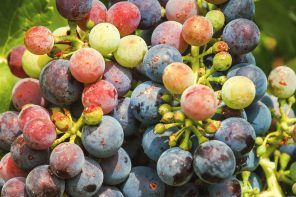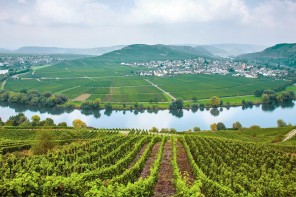By now you know all about terroir. Take soil, add climate, a dash of elevation, a soupçon of aspect, a generous helping of topography and, naturally, the hand of man, and you start to get the basics of that sometimes confusing term. This synthesis of various geomorphic features and viticultural know-how is what gives us wine fiends that alcoholic drink we love so.
But looking closer at the crème de la crème of the world’s wine regions, we see a pattern begin to emerge. Many of the top appellations share a common theme: proximity to water. Why does water matter? The answers begin to unfold when we consider climate.
Climate plays a major role when it comes to the grapes’ ability to grow and ripen. Generally speaking, the Goldilocks zone for growing grape vines is between 30° and 50° latitude, north and south. In regions with marginal climates, a body of water can mean do or die for vines. Rivers, lakes, and oceans will dramatically change what can happen during the growing season. Here’s how.
Rivers
Many of our favorite wine regions have rivers trickling through their landscapes. Rivers make viticulture possible in regions where it gets really cold or really hot. Steep slopes can be a common feature around rivers. In cooler regions, this is a real boon for growing wine grapes. Heat rises and cold sinks – so cold air will settle at the bottom of a slope and your uphill vines will be less likely to suffer from spring frost or freezing spells.
Another little bonus is that vineyards planted on the banks of rivers receive the benefit of reflected sunlight and heat. It’s virtually a must-have in marginal climates like German fine wine regions such as the Rheingau or Mosel.
But rivers don’t just facilitate winemaking vines in cooler areas. In warm-to-hot climates, vines planted on the steep slopes of the riverside benefit from cooler nights. As a result, grapes preserve acidity. This means the final product may be rich and ripe while still achieving balance via that hallmark mouthwatering acidity that draws us back sip after sip.
In more moderate climates, rivers can lend a hand in encouraging the growth of botrytis cinerea (aka noble rot); France’s Sauternes and Coteaux du Layon and Tokaji in Hungary are a few examples of sweet wine regions adjacent to rivers. The botrytis cinerea fungus needs warm, humid conditions to take, and rivers lay the groundwork for the creation of many of the world’s most legendary dessert wines.
As if all this wasn’t enough, these steeper riverside conditions put stress on the vines, which ultimately yields higher quality berries. Poor soils and limited access to water equal struggling vines which create more flavorful grapes – always a good thing. Moreover, back in the day, rivers also served an important role in shipping wines to various markets.
Lakes
Water is rather effective at storing heat and can act as a natural heater once the Mercury dips. This is simply due to the fact that water takes longer to change temperature compared to air. In short, lakeside northerly wine regions can not only make wine but make damn fine wine at that. Their resident lakes help prevent the threat of sudden frosts. Think the Finger Lakes and Okanagan Valley. A warmer lake can also contribute to making the growing season last that little bit longer, ensuring grapes ripen to perfection before they’re harvested. On the other side of the coin, a cooler lake will help moderate summertime temperatures, so grapes hang on to their acid levels.
And like rivers, lakes can also play a major role in promoting the spread of botrytis. Large, shallow lakes like Austria’s Lake Neusiedl not only moderates the climate of the region but improves the humid conditions needed for botrytis.
Sea
While proximity to the ocean can bring a slew of viticultural hazards (i.e. humidity, wet weather), in warmer climates, the cooling ocean breezes preserve much-needed acidity in the grapes. As you’ll know by now, the hotter the climate, the easier it is for grapes to ripen. Maintaining the acidity to create balanced wines can become a challenge. Cool currents and the fogs and coastal zephyrs they produce mitigate daytime heat in the vineyards. A few wine regions which benefit from coastal influence include South Africa’s Western Cape, the California appellations of Napa, Sonoma and Santa Barbara, in addition to parts of Portugal and Spain (check out Sherry).
Whether you prefer sipping on a rich Douro red, a racy Rheingau Riesling, or ending your meal with a magnificent noble rot wine, the next time you enjoy a glass, take a minute not only to savor the flavors dancing across your palate, but also to appreciate the influence that the world’s rivers, lakes, and oceans have on your wine. They make a delicious difference.








